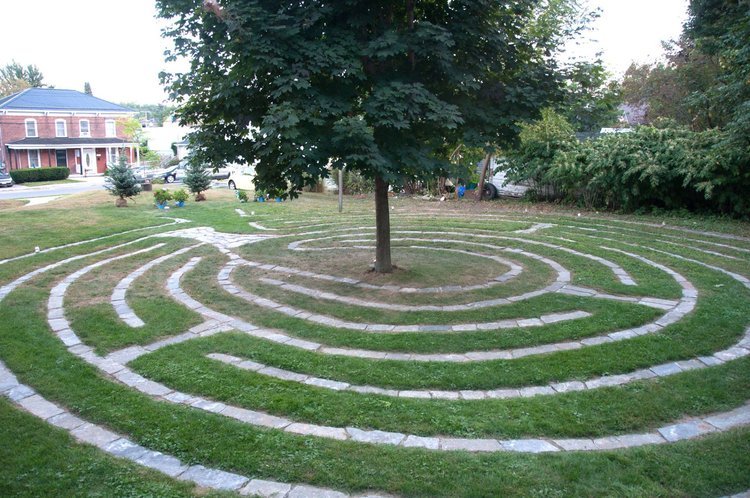The Labyrinth is a Pathway to Inner Peace.
For the longest time, I thought a labyrinth was more like a maze and avoided experiencing it based on my childhood experience of mazes. Toronto Island has a giant maze on Centre Island, and on one visit, we took my cousin and his family, who were visiting from Australia, to the Island for the day. I remember being excited to run through the many twists and turns of the maze, only to end up being petrified because I was lost. Luckily, I ran into my cousin, who kindly guided me to the entrance. However, the fear of getting lost made me reluctant to try the maze on future visits to Centre Island.
There is a beautiful labyrinth at St. Andrew’s Church in Picton, where my daughter exchanged her wedding vows in July. This labyrinth introduced me to its spiritual significance when we moved here 4 years ago.
I wish I had had this awareness decades ago when I was a minute's walk from an enormous labyrinth while working at Old City Hall (the busiest courthouse in Toronto, Canada). I passed by this labyrinth daily in Trinity Park behind Old City Hall and always found it weird when I witnessed people walking it. I now know I missed an excellent opportunity to reap the benefits of a powerful walking meditation. Boy, did I need it after working long hours as the Program Manager in Canada’s first mental health court and all the chaos that naturally occurs in the criminal justice system.
Thankfully, I now know that a maze differs entirely from a labyrinth. Mazes have multiple paths that branch into different directions, often have dead ends, and have many entry and exit points. They create confusion, so you purposely get lost. They can be fun, but I’ve never found them very relaxing.
A labyrinth has one entrance that is also the exit. There is only one path to follow that is not challenging to navigate, and the best part for me is that you can’t get lost. It has a centre that allows time for pause or prayer.
“Labyrinths are cross-cultural and ancient, having been part of human society for more than 4,000 years. Artforms across nearly every continent contain the “classical labyrinth symbol” dating back to 2000 BCE.” Source
“A labyrinth is an ancient spiritual tool designed to foster contemplation and spiritual transformation. Walked by contemplatives and lay people alike for centuries, labyrinths are typically formed as a circle with a singular path leading to a center and constructed out of a wide range of materials. Labyrinths today can be found embedded into the architecture of old churches, in the middle of remote forests, on rocky coastlines, in home gardens, and near contemporary community centers. “ Source
The labyrinth is an analogy for life. It has short and long curves, like the ebb and flow of energy, and sometimes you can’t quite see where you are going but still keep moving, like how we don’t always know what life will bring us.
Benefits of Labyrinth Walking.
Binghamton University describes Labyrinths: “Labyrinths are used world-wide as a way to quiet the mind, calm anxieties, recover balance in life, enhance creativity and encourage meditation, insight, self-reflection and stress reduction. The practice of labyrinth walking integrates the body with the mind and spirit,”
Even though there are few studies regarding the benefits of labyrinth walking, labyrinths are popping up at churches, public parks, hospitals, treatment centres, prisons, and hospices. Access to a labyrinth was made available to individuals with co-occurring substance use and mental health challenges at a treatment centre. A study posted in Harvard Psychiatry showed that the feedback from the patients was that they felt “deeply relaxed” and fully engaged; mentally stimulated, contemplative, open, and clear; and spiritually connected.
How to use a Labyrinth.
The labyrinth is mysterious and has ancient roots that I think about when walking it. There are numerous ways to use the labyrinth because there are no rules, and there are many types of labyrinths, some large, some small, and some more complex than others. Walking the labyrinth is a solo experience, and here are a few ways to walk it:
· A walking meditation is an excellent alternative to a traditional seated meditation that some people find challenging.
· You can walk the labyrinth silently and notice where your mind goes.
· You can sync your steps with your breathing.
· Repeat a mantra or prayer.
· Walk in remembrance of someone who has passed away.
· You can go in with a question, which is helpful if you are indecisive.
· Labyrinths are often used for rituals and ceremonies like the Summer or Winter Solstices.
· Walk the labyrinth on special occasions like birthdays and New Year’s Day.
· A special place to exchange vows.
St. Andrew’s Labyrinth.
Winter Solstice Labyrinth Walk.
I’ve walked the labyrinth at St. Andrew’s in Picton many times. Sometimes, I’m the only one there and focus on my breathing and steps; other times, I’ve been with a group celebrating the Winter Solstice when the labyrinth is glowing with candles.
Labyrinths are worldwide; I’m grateful for one in my small town. Most large cities have several, and you can check out this Labyrinth Locator to see if there is one close to you.
Walking a labyrinth is a spiritual practice that provides a pathway to inner peace and promotes well-being. I have always felt lighter and more joyful after a walk on the labyrinth and have found it to be a perfect way to clear my mind and gain clarity. While walking to the centre, you find your centre.
Be well & centred.
Anita




